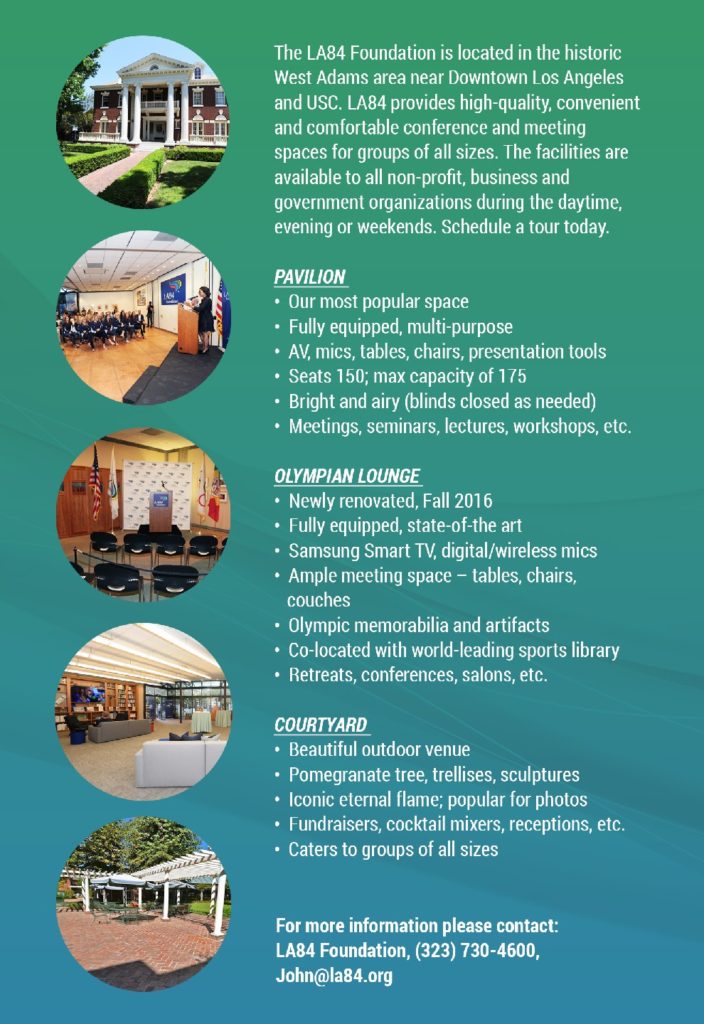PEP PRACTICAL GUIDE
The Santa Monica Orthopaedic and Sports Medicine Research Foundation, through a grant from the LA84 Foundation, has designed the PEP Program: Prevent Injury and Enhance Performance. It is a soccer-oriented exercise program designed by doctors, physical therapists, and athletic trainers to reduce the incidence ACL injuries in soccer.
The PEP Program can be done on a field. It requires no special equipment. The PEP Program takes approximately 15 to 20 minutes to complete and should replace your standard warm-up routine. The exercises should be completed in the order listed below. The program should be done two or three times each week.
LEARN MORE: View the 2016 LA84 Foundation Youth Sports Survey
There are 20 PEP exercises. They fall into five categories: avoidance, flexibility, strengthening, plyometrics, and agilities. These 20 exercises should be done at the beginning of practice. In addition, there are four optional cool down exercises that can be performed at the end of the practice session, before players go home. You can see all of these exercises demonstrated in the video portion of this web-based lesson.
The PEP exercises described here are for athletes who are at least 12-years-old. Younger athletes should use a modified version of PEP. Please contact Holly Silvers, the PEP Project Coordinator, at HollySilversPT@aol.com regarding modifications.
AVOIDANCE
Avoidance, the first step of the program, stresses avoiding injury by teaching good running technique. Concentrate on keeping the knees flexed and the hips and knees over the ankles. The three avoidance exercises should be done with little or no rest between each one. They also serve as a warm-up for the flexibility exercises that follow.
A. Jogging
B. Shuttle Run with Sidestepping
C. Backward Run
Instruction: Do each of these exercises by running 40 to 50 yards, two times.
FLEXIBILITY
Flexibility, or stretching, exercises follow the avoidance exercises. It is important to warm-up with the avoidance exercises prior to stretching. Never stretch a cold muscle. By performing these stretches, you can improve your range of motion, reduce joint stiffness, and reduce post-exercise soreness, reduce the risk of injury and improve your overall performance.
GENERAL GUIDELINES FOR STRETCHING
- Do a large muscle warm-up such as light running/jogging for five to 10 minutes before stretching.
- Don’t bounce or jerk when you stretch.
- Gently stretch to a point of tension and hold.
- Hold the stretch for 30 seconds. Concentrate on lengthening the muscles when you’re stretching. Repeat 2 times on each side.
- Breathe normally. Don’t hold your breath.
A. Calf Stretch
Instruction: Stand leading with your right leg. Bend forward at the waist and place your hands on the ground (V formation). Keep your right knee slightly bent and your left leg straight. Make sure your left foot is flat on the ground. Hold for 30 seconds. Switch sides and repeat.
B. Quadricep Stretch
Instruction: Place your left hand on your partner’s left shoulder. Reach back with your right hand and grab the front of your right ankle. Bring your heel to buttock. Make sure you are standing up straight and your knee is pointed down toward the ground. Hold for 30 seconds and switch sides.
C. Figure Four Hamstring
Instruction: Sit on the ground with your right leg extended out in front of you. Bend your left knee and rest the bottom of your foot on your right inner thigh. With a straight back, try to bring your chest toward your knee. Try not to round your back over. If you can, reach down toward your toes and pull them up toward your head. Hold for 30 seconds and repeat with the other leg.
D. Inner Thigh Stretch
Instruction: Remain seated on the ground. This time, spread you legs evenly apart. Slowly lower yourself to the center with a straight back. You want to feel a stretch in the inner thigh. Now reach toward the right with the right arm. Bring your left arm overhead the stretch over to the right. You should feel a good stretch along the left side of your waist. Hold the stretch for 30 seconds and repeat on the opposite side.
E. Hip Flexor Stretch
Instruction: Lunge forward leading with your right leg. Drop your left knee down to the ground. Placing your hands on top of your right thigh, lean forward with your hips. The hips should be square with your shoulders. If possible, maintain your balance and lift back for the left ankle and pull your heel to your buttocks. You should feel this stretch all along the left thigh. Hold for 30 seconds and repeat on the other side.
STRENGTHENING
The third part of the program is strengthening. This is a crucial component of the program. By increasing the strength of the muscles of the leg, you can increase the stability of the hip, knee, and ankle, and thereby reduce the chance of injury.
A. Walking Lunges
Instruction: Lunge forward leading with your right leg. Push off with your right leg and lunge forward with your left leg. Drop the back knee straight down. Make sure that your keep your front knee over your ankle. Keep the hip/knee/ankle in alignment. Keep the shoulders over the hips. Control the motion and try to avoid you front knee from caving inward. If you can’t see your toes on your leading leg, you are doing the exercise incorrectly. Do 30 repetitions.
B. Russian Hamstring
Instruction: Kneel on the ground with hands at your side. Have a partner hold firmly at your ankles. With a straight back, lean forward leading with your hips. Your knee, hip and shoulder should be in a straight line as you lean toward the ground. Do not bend at the waist. If you feel a cramp, stop the exercise, stretch, and then resume. Repeat the exercise for 3 sets of 10, or a total of 30 repetitions.
C. Single Toe Raises
Instruction: Stand up with your arms at your side. Bend the left knee up and maintain your balance. Slowly rise up on your right toes with good balance. Slowly repeat 30 times and switch to the other side.
PLYOMETRICS
Next come plyometrics. These exercises are explosive and help to build, power, strength, and speed. The most important element of these exercises is the landing. It must be soft! When you land from a jump, you want to softly accept your weight on the balls of your feet slowly rolling back to the heel with a bent knee and a straight hip. By landing in this manner, you actively contract your hamstring muscles, which reinforces the ACL ligament.
These exercises are basic. It is critical that you perform them correctly. Please take the time to ensure safe and correct completion of these exercises.
A. Side to Side Hops Over Cone
Instruction: Stand with a 6-inch cone or ball to your left. Hop to the left over the cone softly landing on the balls of your feet land bending at the knee. Repeat this exercise hopping to the right. Do 20 repetitions. To complete one repetition you must jump to one side of the cone and then back to the original side.
B. Frontward/Backward Hops Over Cone
Instruction: Stand facing a 6-inch cone or ball that your coach placed on the field for you. Hop over the cone/ball softly landing on the balls of your feet and bending at the knee. Now, hop backwards over the ball using the same landing technique. Be careful not to snap your knee back to straighten it. You want to maintain a slight bend to the knee. Perform 20 repetitions. To complete one repetition you must hop forward and then backward to your original spot.
C. Single Leg Hops Over Cone or Ball
Instruction: Stand facing a 6-inch or 8-inch cone or ball. Hop over the cone/ball landing on the ball of your foot bending at the knee. Now, hop backwards over the ball using the same landing technique. You want to maintain a slight bend to the knee. Do 20 repetitions. Stand on the opposite leg and repeat.
D. Vertical Jumps with Headers
Instruction: Take one step forward with your right leg. Slightly bend the left leg and push off the left foot to jump straight up. Remember the proper landing technique; accept the weight on the ball of your foot with a slight bend to the knee. Do 20 repetitions and switch sides.
E. Scissors Jump
Instruction: Stand forward with hands at your side. Jump forward with your right leg. Keep your right knee over your ankle. Now, push off with your right foot and propel your left leg forward into a lunge position. Look at your positioning ‚ make sure it is correct. Be sure your knee does not cave in or out. It should be stable and directly over the ankle. Remember the proper landing technique; accept the weight on the ball of your foot with a slight bend to the knee. Do 20 times.
AGILITIES
Agilities exercises are the last portion of the program. These involve proprioceptive training; that is, developing your sense of joint position. This allows you to train the knee joint to deal with situations encountered in a game. They are sport specific.
A. Shuttle Run with Forward/Backward Running
Instruction: Set up two lines of cones. The lines should be about ten yards apart. Use eight to ten cones. Space them so that you will make a diagonal pattern as you run from one line to the other. Starting at the first cone, sprint forward to the second cone. Run backward to the third cone. Sprint forward to the fourth cone, and so on. It should take 30 to 60 seconds to run through the course. Perform three times.
B. Diagonal Run
Instruction: Set up cones as described above. Face forward and run to the first cone on the left. Pivot off the right leg (outside foot) and run to the second cone. Now pivot off the left leg and continue onto the third cone. Make sure that the inside leg or the pivot leg does not cave in. Keep a slight bend to the knee and make sure the knee stays over the ankle joint. Perform three times.
C. Bounding Run
Instruction: Starting on the near sideline, run to the far side with knees up toward chest. Bring your knees up high. Land on the ball of your foot. Keep a slight bend at the knee. Your hip should be level, rather than dipping to one side or the other. Increase the distance of the run as this exercise gets easier. Perform 30 to 60 seconds.
If you have any questions or comments about the PEP Program, please contact:
Holly Silvers, MPT
Project Coordinator
Santa Monica Orthopaedic and Sports Medicine Research Foundation
HollySilversPT@aol.com
You can read more about the PEP Program online at www.aclprevent.com.

